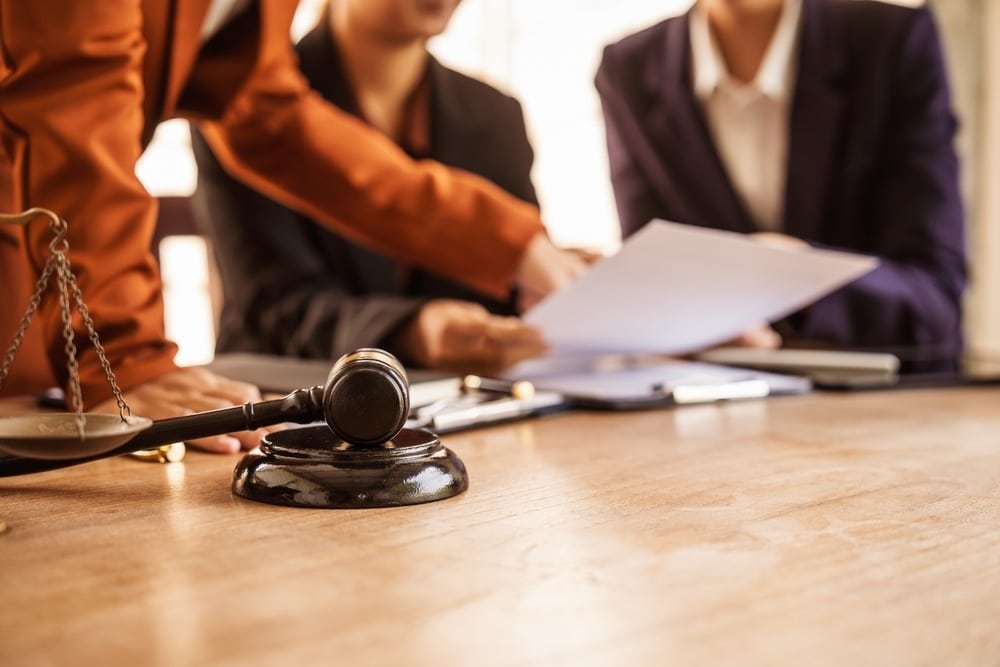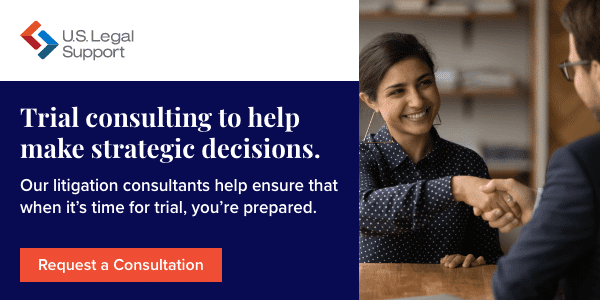Preparing a Winning Trial Strategy

Legal discovery often comprises the longest stage of casework—identifying evidence, developing timelines, and vetting witnesses. The facts, strengths, and weaknesses of a case provide puzzle pieces that attorneys identify and review before arranging them into a cohesive trial strategy.
Trial strategies are comprehensive plans that connect each step of negotiations and courtroom performance to present the judge, jury, and opposition with a consistent underlying argument that best represents your client’s position. More than a simple claim or single argument, a trial strategy is generally foundational to achieving a favorable outcome for your client.
Understanding the Importance of a Trial Strategy
A trial strategy outlines how to approach a legal matter, providing an overarching plan that guides each individual tactic, such as theme, arguments, and lines of questioning. For many cases, the strategy includes getting the jurors to identify with your client to gain their sympathy or outrage and side with their actions or suffering.
Strategy must be present before the first day of a trial, influencing discovery choices and voir dire questioning to establish counsel’s intended direction. It takes center stage during opening statements, and the trial strategy becomes reinforced by each witness examination and cross to deliver a consistent, A-to-Z plan of engagement.
Legal professionals and lawyers commonly hear the claim that 80% of jurors decide their vote during opening arguments; however, while this is not a scientifically backed statement, research does show that final verdicts tend to follow the voting breakdown of a given jury’s first ballot. Therefore, implementing an effective trial strategy to capture jurors’ sympathy and belief as early as possible often proves critical to winning cases.
Even though trials are the tip of the iceberg when it comes to legal outcomes, with 97% of criminal and 95% of civil federal cases settled outside of court, trial strategies remain essential to case preparation.1,2 Understanding and predicting how a strategy will perform before a judge and jury is critical to achieving a positive result for your client at any stage of proceedings, and it’s often the leverage to achieve desired pretrial outcomes.
Developing a Customized Trial Strategy for Your Case
While trial strategies can typically be categorized under a limited number of known arguments, they aren’t cookie-cutter approaches that can be interchanged among clients. Individual facts, available evidence, client and witness believability, and even factors like the effect of socioeconomic changes on community values all come together to inform how to craft a bespoke trial strategy for a particular case.
Your trial strategy encompasses:
- Crafting the most compelling argument in favor of your client’s interests
- Leveraging results of jury research on demographics, psychographics, and other factors
- Selecting, organizing, and analyzing evidence
- Planning pretrial motions and filings
- Sequencing evidence and witnesses
- Designing and creating persuasive supporting exhibits and presentations
Consider these best practice steps for strong trial strategy development:
- Understand your case arguments, strengths, and weaknesses thoroughly.
- Research applicable case law and precedents both for and against your strategy.
- Prepare counterarguments for expected opposition approaches.
- Develop a sticky and compelling trial theme that’s repeated throughout the entire trial.
- Utilize best practices and technology advances to plan tactics.
- Test, refine, and retest your tactics.
Breaking Down the Key Elements of a Successful Trial Strategy
A successful strategy requires trial preparation, consistency, and cohesion across trial tactics and decisions. The strategy influences all stages of a trial, typically starting from the first client interview and undergoing refinement throughout the discovery process.
Evidence Collection and Presentation
The decision to represent a client is usually when the trial strategy begins. Carefully collecting and organizing evidence is important so the attorney can analyze all the information for a successful outcome.
During discovery, identify:
- Patterns, facts, and perspectives that either reinforce or contradict an initial trial strategy
- Sources that require time or effort to obtain, such as medical records requests
- How to overcome arguments and strategies in which the opposition is likely to engage
After organizing facts, authenticated evidence, and witnesses, and focus on how their presentation can support your trial strategy.
While people often think of design in connection with advertising, the entirety of data visualization and graphic and information design is based on the use of proven principles to convey information in support of a given end goal. Trial graphics and demonstratives make up their own specialized subfield that incorporates both sophisticated design principles and an understanding of courtroom protocol and evidentiary rules.
It’s particularly critical to engage skilled trial presentation experts to:
- Present scientific or technical data to laypersons.
- Reinforce connections and causalities.
- Illustrate timelines and narratives.
- Elicit a strong emotional or sympathetic response.
Witness Preparation and Cross-Examination
Thorough preparation is the only way to dodge as many witness wildcards in the courtroom as possible. Vet your witnesses and ensure their information and demeanor align with your trial strategy for both direct examination and anticipated cross.
Consider these options:
- Use mock trials with either the witness present or with deposition videos.
- Incorporate hostile witness questioning to better prepare your witnesses.
- Ask colleagues to review witness testimony in a devil’s advocate role.
- Check for new approaches with AI drafting of both sides’ direct and cross questions.
When it comes to the nitty gritty of preparing clients and witnesses for the opening day of trial, be sure to cover:
- Verbal and nonverbal cues supporting perceived truthfulness and juror comprehension
- Self-presentation including conservative dress and grooming
- Technical aspects for remote trials such as flattering lighting, background, and framing
Jury Selection and Influence
Who can best identify and sympathize with your client, and how do you engage with them? Winning over a jury starts before the trial with jury research and then how you apply your peremptory and for-cause challenges.
You can boost a winning strategy with these steps:
- Use surveys and focus groups to research the jury pool’s values, opinions, and beliefs.
- Engage jury selection experts prior to and during voir dire.
- Gain more insight into selected jurors by ethically researching public information sources.
The more information you have on the jury, the more you can tailor your trial strategy tactics—including theme, language, demonstratives, and emotional appeal—to your actual jurors.
Adapting Your Trial Strategy During Court Proceedings
In a perfect world, you’d be able to anticipate every step of a trial. In reality, however, a carefully planned strategy needs to include flexibility to address unanticipated:
- Lines of inquiry, questioning, or objections by the opposition
- Witness performance with the pressure of court appearance and cross-examination
- Judges’ rulings and directions to the jury
- Jury reactions and concerns
Legal teams can use these steps to prepare for on-the-fly adjustments:
- Draft if/then examination and cross questions for key witnesses.
- Include variables and replacement modules in final arguments and key presentations.
- Identify potential impeachment evidence dependent on the opposition’s examinations.
Common Mistakes to Avoid in Trial Strategy Development
Lack of preparation can be the biggest mistake in trial strategy development. Missing key steps during discovery and strategic planning can create vulnerabilities as you approach the trial process.
As you craft your trial strategy and supporting tactics, avoid3:
- Inconsistency in messaging or narrative, including across filings to the judge
- Failure to plan case or statute support against counterarguments and motions
- Failure to consider a bench trial versus a jury trial and adapt trial strategy accordingly
Building the optimal trial strategy starts during discovery, so watch out for these mistakes:
- Insufficient discovery requests or responses
- Failure to arrange your own video recording of depositions
- Assumptions about what evidence will be accepted or what hearsay will be excluded
As trial dates approach, beware of these common missteps:
- Inadequate practice and preparation of your opening and closing statements
- Mishandling or not planning for restraining orders and injunctions
- Failure to list legal theories and claims or omitting elements of claims
- Late expert disclosure
- Failure to plead enough facts in cases that require particularity
Work with the Experts at TrialQuest and U.S. Legal Support
If you’re in need of trial strategy development or are already deep into a legal matter, we invite you to connect with TrialQuest, the trial services division of U.S. Legal Support.
TrialQuest is uniquely positioned to help you develop, test, and refine your trial strategy with a team of experienced jury consultants, Ph.D. behavioral scientists, and psychologists who’ve consulted on more than 53,000 high-risk trials, arbitrations, and mediations across all practice areas and jurisdictions.
In addition to strategic consulting, we provide trial graphics and demonstratives that leverage the art and science of capturing attention and leading viewers to a conclusion, jury research and consulting, mock trials, witness preparation, and trial presentation and technology services.
Plus, U.S. Legal Support can connect you with a network of 5,000+ court reporters and provide process service nationwide, in addition to interpreting, translation, and record retrieval, organization, and analysis services.
Contact us today to discuss how we can help with your trial strategy and other litigation support service needs.
Sources:
- The Outline. Most criminal cases end in plea bargains, not trials. https://theoutline.com/post/2066/most-criminal-cases-end-in-plea-bargains-not-trials
- The Law Dictionary. What Percentage of Lawsuits Settle Before Trial? What Are Some Statistics on Personal Injury Settlements? https://thelawdictionary.org/article/what-percentage-of-lawsuits-settle-before-trial-what-are-some-statistics-on-personal-injury-settlements/
- The Jensen Litigation Firm, PLLC. 100 Civil Litigation Mistakes To Avoid In Minnesota Courts. https://www.jensenlawmn.com/100-civil-litigation-mistakes-mn
- Chicago Unbound. A Jury Hoax: The Superpower of the Opening Statement. https://chicagounbound.uchicago.edu/cgi/viewcontent.cgi?httpsredir=1&article=12000&context=journal_articles

Editoral Policy
Content published on the U.S. Legal Support blog is reviewed by professionals in the legal and litigation support services field to help ensure accurate information. The information provided in this blog is for informational purposes only and should not be construed as legal advice for attorneys or clients.


